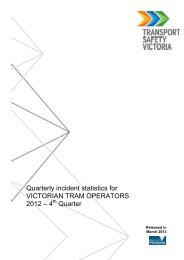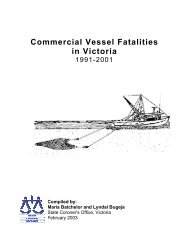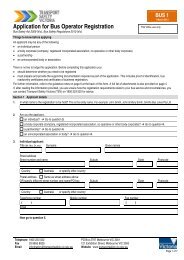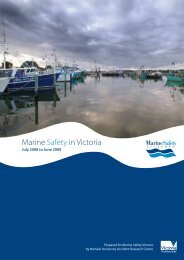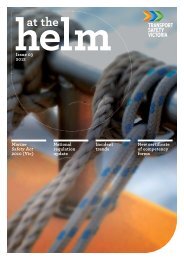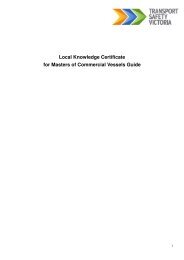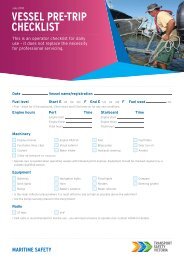Marine Safety in Victoria Report 2007-2008 (PDF, 1.3 MB, 72 pp.)
Marine Safety in Victoria Report 2007-2008 (PDF, 1.3 MB, 72 pp.)
Marine Safety in Victoria Report 2007-2008 (PDF, 1.3 MB, 72 pp.)
Create successful ePaper yourself
Turn your PDF publications into a flip-book with our unique Google optimized e-Paper software.
Our literature search found only one recently published research article relevant to general boat<strong>in</strong>g safety.<br />
Miller & Pikora (<strong>2008</strong>) undertook a telephone survey of a sample of 500 adult registered boat owners<br />
<strong>in</strong> Western Australia to explore their use of alcohol when boat<strong>in</strong>g. The response rate was 47%. The<br />
researchers used logistic regression analysis to determ<strong>in</strong>e the effects of a range of demographic variables<br />
and boat<strong>in</strong>g characteristics on the use of alcohol among recreational boaters on their last trip.<br />
The use of alcohol was not found to be prevalent among WA recreational boat owners with 19% report<strong>in</strong>g<br />
that they had consumed alcohol of their most recent boat<strong>in</strong>g trip. Previous research, ma<strong>in</strong>ly conducted <strong>in</strong><br />
the U.S., had reported that 30-40% of recreational boaters consume alcohol when on the water. The WA<br />
study only <strong>in</strong>cluded owners of registered vessels and not their passengers which may account for some of<br />
this difference <strong>in</strong> prevalence levels.<br />
Two variables were found to be significantly and <strong>in</strong>dependently associated with alcohol consumption on<br />
the most recent trip. First, those with no boat<strong>in</strong>g education were 45% more likely to report consum<strong>in</strong>g<br />
alcohol on their most recent trip compared with those who had completed a boat<strong>in</strong>g education course<br />
(OR 0.55; 95% CI 0.32-0.95). Previous studies had found no significant difference <strong>in</strong> the consumption of<br />
alcohol while boat<strong>in</strong>g between those who had been formally tra<strong>in</strong>ed and those who had not or that<br />
boaters who had completed boater safety tra<strong>in</strong><strong>in</strong>g were significantly more likely to consume alcohol when<br />
boat<strong>in</strong>g than those who had not.<br />
Second, those who did not have children aged less than 12 years on board were 63% more likely to report<br />
consum<strong>in</strong>g alcohol than those who did have children on board (OR 0.37; 95% CI 0.22-0.63) <strong>in</strong>dicat<strong>in</strong>g that<br />
boaters that carry children may be more safety conscious.<br />
The authors of the WA study made a general recommendation that education, legislation and other<br />
measures to reduce boat<strong>in</strong>g <strong>in</strong>cidents be monitored over time to determ<strong>in</strong>e the effect of these strategies<br />
on safety behaviours.<br />
Other preventive measures recommended <strong>in</strong> earlier research reports <strong>in</strong>clude: extend<strong>in</strong>g skills and safety<br />
tra<strong>in</strong><strong>in</strong>g for boat operators (<strong>in</strong>clud<strong>in</strong>g on-water and boat launch/dock<strong>in</strong>g skills); <strong>in</strong>stitution of boat ramp<br />
upgrades and regular safety <strong>in</strong>spections and associated ma<strong>in</strong>tenance programs by responsible authorities;<br />
promotion of the adoption of regular vessel, fitt<strong>in</strong>gs and equipment ma<strong>in</strong>tenance regimes and safety<br />
checks by boat owners/operators; and <strong>in</strong>itiatives to <strong>in</strong>crease the wear<strong>in</strong>g of personal protective equipment<br />
by boat occupants (PFD, slip resistant shoes and gloves when do<strong>in</strong>g tasks that carry a risk of f<strong>in</strong>ger/<br />
hand <strong>in</strong>jury).<br />
Prevent<strong>in</strong>g <strong>in</strong>jury <strong>in</strong> PWC rid<strong>in</strong>g<br />
Personal watercraft-related <strong>in</strong>juries accounted for 9% of recreational boat<strong>in</strong>g hospital treated <strong>in</strong>juries<br />
(80/902 cases) <strong>in</strong> 2006/7. There were 13 fewer recorded cases <strong>in</strong> 2006/7 than <strong>in</strong> 2005/6.<br />
The age-related pattern <strong>in</strong> 2006/7 was slightly different than <strong>in</strong> previous years where <strong>in</strong>jured PWC riders<br />
were shown to be mostly young males aged 20-39 years. In 2006/7, hospital admissions among the 45-49<br />
year age group were as frequent as among 25-29 year olds and 35-39 year olds.<br />
The lower extremity, head/face and the trunk were the most frequently <strong>in</strong>jured body sites. Fractures, open<br />
wounds, spra<strong>in</strong>s and stra<strong>in</strong>s and <strong>in</strong>tracranial <strong>in</strong>juries were common <strong>in</strong>juries. Available data <strong>in</strong>dicate that the<br />
major causes of <strong>in</strong>jury were falls from the PWC, and collisions with a fixed object (usually a part of the PWC)<br />
or mov<strong>in</strong>g objects (most commonly their own or another PWC). These results are consistent with f<strong>in</strong>d<strong>in</strong>gs<br />
from previous studies of patients treated <strong>in</strong> emergency departments and trauma centres (Latch & Fiser,<br />
2004; Branche et al., 1997).<br />
62



